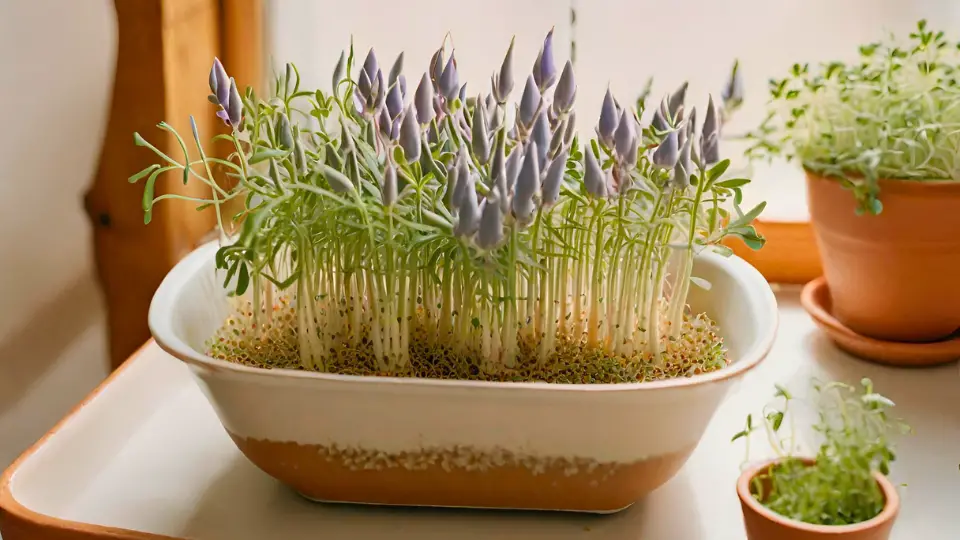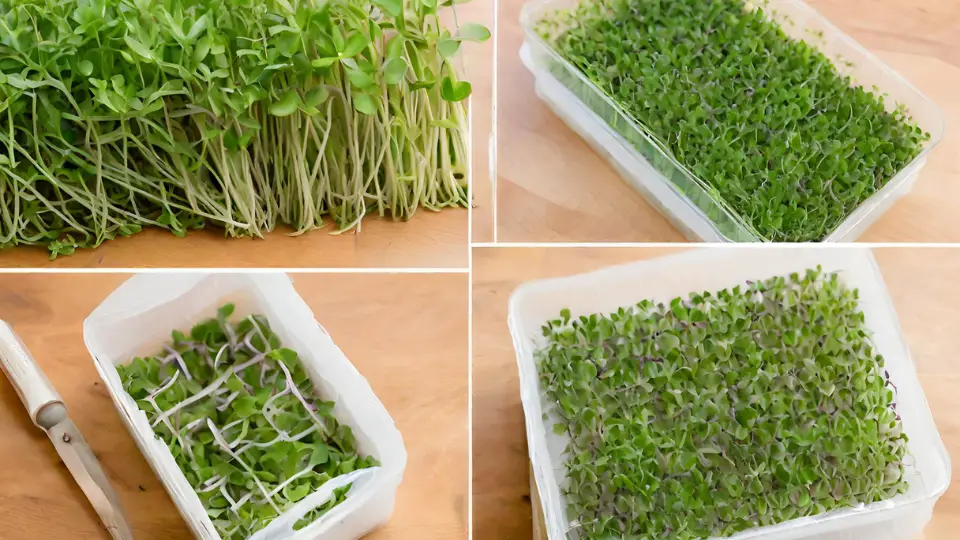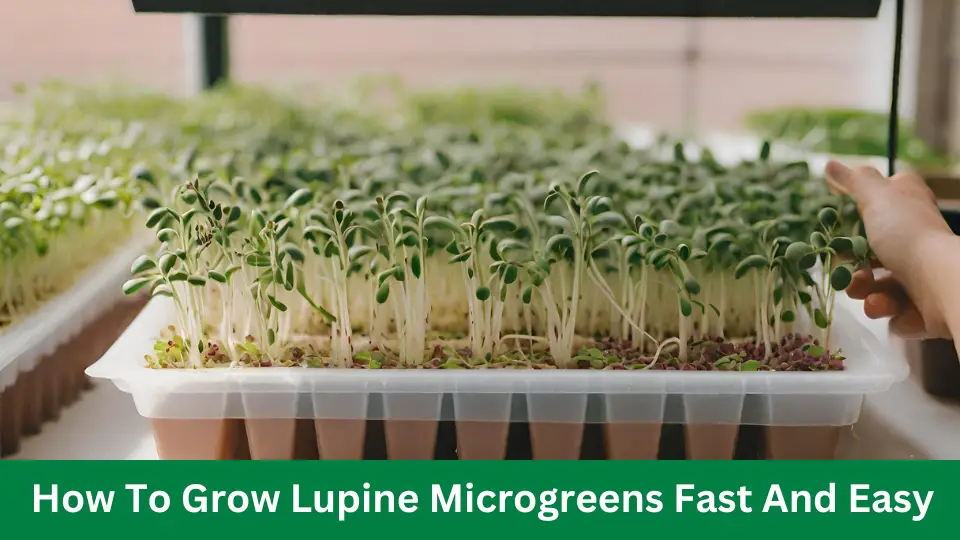Lupine microgreens, known for their vibrant color and peppery flavor, are edible young greens harvested from lupin seeds. These nutrient-rich microgreens enhance both the visual appeal and nutritional value of dishes.
Lupine microgreens represent the early growth stages of the lupine plant, typically harvested just after the first leaves develop. These tiny greens offer a powerful punch of vitamins and antioxidants, along with a distinctive, slightly spicy taste that complements a variety of culinary creations.
They grow quickly and can be easily cultivated at home or by commercial growers, providing a rapid, fresh crop. Integrating lupine microgreens into your diet can be both a gourmet and a health-conscious choice, making them popular among chefs and health enthusiasts. These small but mighty plants are making big waves in gardening, cooking, and healthy living for their ease of growth and versatility in the kitchen.
Nutritional Profile And Benefits
Delving into greens, Lupine microgreens stand out for their vibrant hues and impressive nutritional composition. Power-packed with essential nutrients, these tiny greens are a powerhouse of health benefits that cater to various dietary needs. Whether you’re a fitness enthusiast, a health-conscious individual, or simply someone who loves to incorporate wholesome foods into your diet, Lupine microgreens are a superfood worth exploring. Let’s unpack their remarkable nutritional profile and benefits.

High Protein Content Compared To Other Microgreens
It’s no secret that protein is crucial for muscle repair, growth, and overall body function. Lupine microgreens take center stage when it comes to microgreens. They contain significantly more protein than their peers, making them an excellent choice for those looking to boost their protein intake from plant-based sources. This high protein content ensures that each bite of Lupine microgreens tantalizes your taste buds and contributes to your daily nutritional goals.
Rich In Vitamins And Minerals
Lupine microgreens are nutritionally superior beyond protein. They are laden with essential vitamins and minerals necessary for maintaining optimal health. Packed with vitamins A, C, E, K, and the B complex, along with minerals such as iron, calcium, magnesium, and potassium, Lupine microgreens are a nutritional beacon. This potent combination supports a range of bodily functions, from bolstering the immune system to strengthening bones and teeth.
- Vitamin A: Supports eye health and immune function
- Vitamin C: Aids in skin health and antioxidant protection
- Vitamin E: Plays a role in cellular repair and skin health
- Vitamin K: Is essential for blood clotting and bone metabolism
- B Vitamins: Are critical for energy metabolism and brain function
- Minerals: Support heart health, muscle function, and nerve signaling
Presence Of Antioxidants And Bioactive Compounds
The benefits of Lupine microgreens transcend their vitamin and mineral content to include a diverse array of antioxidants and bioactive compounds. These microgreens contain notable polyphenols and phytosterols, compounds known for their role in combating oxidative stress and promoting heart health. Additionally, the presence of these compounds contributes to regulating blood sugar levels and provides anti-inflammatory benefits, which are vital for preventing chronic diseases and maintaining overall health.
Growing Lupine Microgreens At Home
Embark on a journey of green goodness by growing Lupine microgreens right at home! These nutrient-packed tiny greens offer benefits and infuse a unique, peppery flavor into your dishes. Whether you’re a seasoned gardener or a newbie to the plant world, cultivating Lupine microgreens is a breeze with the right approach. Let’s explore the steps to grow a lush, verdant crop.
Choosing The Right Soil And Seeds
Initiating your microgreen adventure begins with two critical elements: high-quality Lupine seeds and the perfect soil mix. Look for non-GMO, organic seeds to ensure purity and optimal health benefits, and pair these with a soil mix that boasts excellent water retention and is free from synthetic chemicals.
- Organic Seed Options: Ensure your seeds are certified organic for the best growth and health.
- Soil Mix: A mix containing peat, vermiculite, and compost works wonders for microgreens.

Steps For Sowing And The Germination Process
Sowing your Lupine seeds is a straightforward process that sets the stage for successful germination. Follow these simple steps for the best results:
- Prepare a shallow tray with two inches of your chosen soil mix and moisten the soil
- Scatter the seeds evenly across the surface, ensuring minimal overlap
- Cover the seeds with a thin layer of soil and gently press down to ensure contact
- Utilize a spray bottle to mist the soil surface lightly, and cover the tray with a lid or plastic wrap to maintain humidity.
Germination typically occurs within 5-7 days, during which you should keep the soil consistently moist but not soggy. Monitor daily and provide gentle ventilation by slightly opening the cover.
Optimal Environmental Conditions For Growth
| Condition | Optimal Range |
|---|---|
| Light | 14-16 hours of indirect sunlight or grow light |
| Temperature | 60-70°F (15-21°C) |
| Humidity | 40-60% |
| Watering | Bottom-watering to prevent mold and overwatering |
Once germinated, remove the cover and continue to monitor and adjust these conditions to ensure your Lupine microgreens thrive. Rotate the tray daily to encourage even growth, and within two to three weeks, you’ll be ready to harvest and enjoy!
Harvesting Your Microgreens
Enthusiasts and gourmets celebrate Lupine microgreens for their nutritional punch and vibrant hues. Rich in vitamins and minerals, these tender shoots enhance any dish. Cultivating microgreens ensures peak freshness and nutritional value, but the most crucial step is harvesting them correctly. Knowing when and how to harvest can drastically affect taste and shelf life. Let’s dive into the right timing and techniques for harvesting Lupine microgreens, ensuring you reap the best of what you sow.
Identifying The Right Time To Harvest
The key to the perfect harvest lies in timing. Lupine microgreens typically reach their harvest-ready stage 10 to 14 days after planting. Key indicators to look out for include:
- The appearance of two fully developed cotyledon leaves, possibly with one set of true leaves starting to emerge,
- A height of around 1 to 3 inches, which usually indicates maturity.
- A rich, green color that signifies a high level of nutrients ready to be enjoyed.
Harvesting too early can result in less flavorful greens, while waiting too long might lead to a decline in quality and possibly more rigid leaves.
Techniques For Cutting And Storing Lupine Microgreens
Once your lupine microgreens have peaked, it’s time for harvesting. A strategic cut and proper storage are vital for preserving their delicate taste and texture.
- Cutting: Use a clean, sharp knife or scissors to cut the microgreens above the soil line. This approach minimizes damage and prevents soil contamination.
- Cleaning: Gently rinse the greens to remove any seed husks or soil residue. Be careful, as their delicate nature makes them prone to damage.
- Drying: Pat the microgreens dry with a paper towel or use a salad spinner to remove excess moisture. This step is crucial to prevent spoilage during storage.
- Storing: Place the microgreens in a breathable container or a sealed plastic bag with a damp paper towel to maintain humidity. Store them in the fridge to prolong freshness.
For optimal storage, keep lupine microgreens around 36 to 40 degrees Fahrenheit. They can last up to a week when stored properly, although consuming them within the first few days captures their maximum flavor and vitality.

Innovating Dishes With Lupine Microgreens
Innovating Dishes with Lupine Microgreens presents a unison of taste and health that can effortlessly elevate an ordinary meal into a gourmet experience. These vibrant, tender, and nutrition-packed young plants derived from lupine seeds add visual appeal and health benefits to various dishes. Get ready to transform your kitchen into an exciting culinary adventure with the versatile Lupine microgreens.
These microgreens add pops of color and bursts of flavor to your diet. To boost nutrition and presentation, let’s explore creative ways to include these tiny greens in everyday cooking.
Incorporating Into Salads And Sandwiches
Lupine microgreens make a fantastic addition to salads and sandwiches, providing a crunchy texture and a nutty flavor. To integrate these microgreens into your diet:
- Create a base for your salad with a mix of lettuce and spinach.
- Top with a generous handful of fresh lupine microgreens.
- Add other ingredients, like cherry tomatoes, cucumbers, and avocados, for extra nutrition.
- Toss with your favorite dressing, or drizzle with olive oil and a squeeze of lemon.
- Layer lupine microgreens on bread as the green element in your sandwiches or wraps, complementing other fillings.
Garnishing Soups And Main Dishes
Garnishing soups and main dishes with lupine microgreens adds a touch of elegance and infuses meals with an additional layer of flavor and nutrients. To enhance your words:
- Sprinkle a small handful of lupine microgreens atop a bowl of soup just before serving.
- Garnish main dishes, such as grilled meats or fish, providing a refreshing contrast.
- Use as an edible garnish on savory breakfast plates like omelets or avocado toast.
Creating Healthy Smoothies And Juices
Lupine microgreens blend seamlessly into smoothies and juices for a dose of vitality. Their subtle flavor pairs well with various fruits and vegetables, supercharging your drinks with essential nutrients. Here’s how to incorporate them:
- Combine a handful of lupine microgreens in a blender with your choice of fruits, like bananas, berries, or mangoes.
- Add a liquid base, such as almond milk, coconut water, or plain yogurt.
- Blend until smooth, and enjoy an antioxidant-rich beverage.
- Start with fresh lupine microgreens as the green component of your juice.
- Add complementary ingredients like carrots, apples, and ginger for a flavor kick.
- Extract the juice using a juicer and savor the fresh, green elixir.
Storing And Preserving Freshness
Lupine microgreens bring a burst of nutrition and vibrant color to any dish, but maintaining their freshness from farm to fork requires some know-how. Like delicate flowers, which need the right environment to stay fresh, these tiny greens need proper storage to preserve their crisp texture and intense flavor. Let’s dive into the best practices to keep your lupine microgreens alive and thriving after harvest.
Methods For Refrigerating Microgreens
Refrigeration is crucial for extending the shelf life of lupine microgreens. Employing the proper technique can be the difference between enjoying crisp greens or tossing them prematurely. Here’s how to get it right:
- Airflow: Ensure containers allow for slight air circulation. Too much moisture can be detrimental, causing decay.
- Temperature: Aim for a steady 2-4°C (35-40°F), which most refrigerators can easily maintain.
- Humidity: Maintain a humidity level of approximately 95% to prevent wilting and preserve crispness. Use a humidifier or a wet paper towel in the storage container to regulate moisture levels.
- Container: Opt for vented plastic containers or sealed bags with a piece of paper or cloth towel at the bottom to absorb any excess moisture.
Tips For Keeping Microgreens Crisp And Flavorful
Proper handling before and after refrigeration is key to keeping lupine microgreens crisp and flavorful. Here are practical tips for maximum freshness:
- Harvesting Time: Harvest in the excellent morning hours when the plants are most turgid. This ensures peak freshness.
- Gentle Washing: Rinse gently to avoid bruising. Use cold water and a salad spinner to dry the greens thoroughly.
- Immediate Cooling: Store microgreens in the fridge soon after harvesting and washing to reduce metabolic activity and slow decay.
- Paper Towels: Line the storage container with paper towels to absorb surplus water and replace them anytime they become damp.
By following these tips, you can prolong the life of your crunchy, flavorful lupine microgreens, ensuring they add a nutrition-packed punch to your meals every time.
Managing Common Growing Pains
The process of growing Lupine microgreens is an exciting venture for gardening enthusiasts. While these nutrient-dense greens offer many benefits, they also have unique challenges. Understanding how to overcome common growing pains is essential for a thriving microgreen garden. Below, we explore some effective strategies for dealing with mold and pests. We also troubleshoot poor germination rates, ensuring tender shoots receive optimal light and water levels for robust growth.
Dealing With Mold And Pests
Mold can quickly overrun a microgreen setup, while pests are ever a threat to your delicate lupine shoots. Prevention remains key, so here’s a strategy to keep these issues at bay:
- Ensure proper air circulation by spacing trays adequately and using a small fan if necessary.
- Maintain cleanliness by regularly sterilizing your growing trays and tools.
- Manage humidity levels by adjusting watering schedules and using a dehumidifier in damp environments.
Spot signs of infestation early by inspecting your greens daily. Upon detection, remove affected plants immediately to prevent spread.
Troubleshooting Poor Germination Rates
Experiencing low germination rates with lupine seeds can be disheartening. Success lies in addressing the following factors:
- Check seed quality – only purchase from reputable suppliers to ensure freshness and viability.
- Ensure correct planting depth – lupine seeds benefit from shallow planting to allow for the easy emergence of the shoots.
- Monitor soil temperature – maintaining a consistent warmth can improve germination rates dramatically.
Reevaluate your watering practices; overwatering can lead to seed rot, while under-watering might prevent germination.
Ensuring Adequate Light And Water
Lupine microgreens require a careful balance of light and water for optimal growth:
| Light | Water |
|---|---|
| Provide 12-16 hours of gentle light daily. Use grow lights if natural light is insufficient. | Water twice daily with a fine mist to keep the soil moist but not soggy. |
Observe your microgreens for signs of stress. Leggy, pale greens generally indicate a need for more light, while yellowing may suggest overwatering. Adjust your care routine accordingly to foster a lush, vibrant crop.
Discovering New Health Implications
Embarking on a journey toward optimal health can lead us to discover the remarkable benefits of seemingly humble plants. Lupine microgreens are no exception, emerging as a superfood powerhouse packed with nutrients. Recent scientific inquiries have shed new light on their health implications, raising curiosity and excitement in wellness communities. With a keen eye on the latest research, let’s delve into the potential of these tiny greens to boost our well-being.
Recent Studies On Health Benefits And Risks
The nutritional spotlight has recently focused on Lupine Microgreens, as multiple studies aim to decode their health benefits and potential risks. Rich in vitamins, antioxidants, and essential amino acids, these microgreens have attracted attention for their role in enhancing dietary regimes.
- High protein content that supports muscle growth and repair
- The presence of dietary fiber aids in digestion and satiety
- Antioxidant properties that combat oxidative stress and inflammation
- Vitamins such as A, B, C, and E which are crucial for various bodily functions
Risks associated with lupine microgreens are notably minimal but significant for those with specific allergies. Studies highlight that individuals allergic to peanuts might also react to lupines, given their similar protein profiles. It is crucial to remain aware of possible lupine microgreens side effects and consult a healthcare provider if concerns arise.
| Nutrients | Health Benefits |
|---|---|
| Protein | Muscle maintenance and growth |
| Fiber | Improved digestion and fullness |
| Antioxidants | Reduced cellular damage and inflammation |
| Vitamins | Enhanced immune function and skin health |
Potential Therapeutic Uses For Lupine Microgreens
Exploring lupine microgreens extends beyond their basic nutritional value, revealing potential therapeutic applications. Emerging evidence suggests these microgreens might play a role in managing chronic conditions and supporting overall health.
- Blood sugar regulation through the slow release of carbohydrates
- Reduction of cholesterol levels thanks to their fiber-rich profile
- Management of hypertension by their potassium content, which helps lower blood pressure
- Support for bone health through their calcium and magnesium components
The unique composition of lupine microgreens offers promise for their incorporation into treatment plans. Nonetheless, further research is necessary to fully establish their role in therapy and ensure safety and efficacy.
Lupine Microgreens And Sustainability
Lupine microgreens are emerging as a powerhouse in sustainable agriculture. Known for their rich, nutty flavor and nutritional benefits, these tiny greens pave the way toward a more sustainable and eco-friendly future. The cultivation of Lupine microgreens is a beacon of innovation in our quest for environmental conservation and resource management, as it aligns with global efforts to combat climate change and ensure food security.
Let’s delve into how these small but mighty greens contribute significantly to water efficiency, reducing carbon footprint, bolstering urban farming initiatives, and fortifying food security.
Water Efficiency And Reducing Carbon Footprint
One of the most compelling advantages of growing lupine microgreens is their minimal water requirements. Unlike traditional crops that demand extensive irrigation, microgreens thrive on a fraction of water, maximizing efficiency and minimizing wastage. Here’s how lupine microgreens are making a difference:
- Lower water consumption: With advanced hydroponic systems, lupine microgreens grow quickly using minimal water, reducing the strain on freshwater resources.
- Less water pollution: These greens require fewer fertilizers and pesticides, so the runoff and water contamination risk significantly drops.
Additionally, the reduced carbon footprint associated with lupine microgreens is noteworthy. By growing microgreens locally, transportation emissions are cut down dramatically, supporting our fight against climate change.
Contribution To Urban Farming And Food Security
Lupine microgreens are on the frontline of the urban farming movement. They can be grown in small spaces such as balconies, rooftops, and even indoors, making them an ideal crop for city dwellers. Here’s how they promote urban farming and food security:
- They require minimal space and can be stacked vertically, exemplifying efficient use of urban areas.
- Lupine microgreens grow rapidly, offering a quick turnaround from seed to harvest, ensuring a consistent fresh produce supply.
- By empowering communities to grow their food, these microgreens help to build food resilience in urban settings.
Through these contributions, lupine microgreens support sustainable practices and provide an inclusive approach to food production, vital for a healthier and more self-sufficient society.
Frequently Asked Questions Of Lupine Microgreens
What Are Lupine Microgreens?
Lupine microgreens are the young, edible shoots of the lupine plant. They are packed with nutrients and offer a crisp texture. Great for adding a fresh taste to salads and sandwiches.
How Do You Grow Lupine Microgreens?
To grow lupine microgreens, spread lupine seeds evenly in a tray with soil. Keep the soil moist and provide sufficient light. Germination typically occurs within a week. Harvest in 2-3 weeks.
What Do Lupine Microgreens Taste Like?
Lupine microgreens have a slightly sweet and nutty flavor. Their taste is similar to the mature lupine legume but milder, making them a versatile addition to many dishes.
Are Lupine Microgreens Nutritious?
Yes, lupine microgreens are nutritious. They contain vitamins, minerals, and antioxidants. They are exceptionally high in protein, making them a beneficial addition to vegetarian and vegan diets.
Conclusion
Embracing lupine microgreens offers a world of benefits. These nutrient powerhouses add a vibrant touch to any dish. Full of flavor and health perks, they’re easy to grow, fitting seamlessly into a wholesome lifestyle. Unlock the potential of these tiny greens and revolutionize your meals with their freshness and vitality.
Elevate your culinary game and wellness journey—give Lupine microgreens a try.
Special Thanks to Gardening Upbeat and Video Source: https://www.youtube.com/watch?v=8PUWef0sHD0



